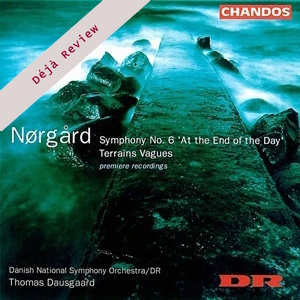
Déjà Review: this review was first published in August 2002 and the recording is still available.
Per Nørgård (b. 1932)
Symphony No 6 “At the End of the Day” (1998/9)
Terrains Vagues (2000, rev. 2001)
Danish National Symphony Orchestra/Thomas Dausgaard
rec. 2000 (Symphony No 6) and 2001 (Terrains Vagues), Danish Radio Concert Hall, Copenhagen, Denmark
Chandos CHAN 9904 [56]
Per Nørgård’s symphonic progress is far from straight, and his six essays so far are important milestones in his output, in that they were often written at crucial stages of his compositional quest. The Sinfonia Austera (No 1), completed in 1955, is the only one that roughly fits into the traditional symphonic mould (bear in mind that Nørgård was a pupil of Holmboe). The Second Symphony (1970/1) is in one single movement, whereas the Third Symphony (1972/5) in two large movements has a chorus in the second movement. The Fourth Symphony (1981), again in two movements, belongs to the particular period in the composer’s composing career in which he was strongly attracted to and, to a certain extent, influenced by the works of the schizophrenic Swiss artist, Adolf Wölfli. This period reached its peak in the opera, The Divine Narcissus (1981/2). Later, the huge Fifth Symphony (1990), written to mark the 125th anniversary of Sibelius and Nielsen, is in one big single movement, falling into four clearly delineated sections.
Now, Nørgård’s latest symphony, completed in 1998/9, is again in three movements (or “passages” as the composer calls them), the last two playing without a break. The Symphony No 6 “…når kommer til alt…” is scored for a huge orchestra including several unusual instruments: double-bass clarinet, bass trumpet, bass trombone, double-bass trombone and double-bass tuba. However, these huge forces are used comparatively sparingly and the low instruments develop their own material without obscuring or drowning the music. Quite the contrary, they often serve as a backdrop for the brighter moments. And it says much for Nørgård’s orchestral mastery that there is nevertheless much clarity and transparency in the scoring, that also has its more imposing moments. Orchestral colour is of course important, as in the brooding slow movement, calling for four cors anglais. This said, it must be added that the Sixth Symphony is a large-scale work of considerable musical substance and of tightly worked-out argument that only yields its secrets after repeated hearings; but that does not fail to impress at a first hearing by the sheer force of its invention, its propulsive energy and – most importantly – its earnestness and honesty. Nørgård has said that this was to be his last symphony, and the rather inconclusive ending has more than one touch of finality.
The more recent orchestral fantasy Terrains Vagues (2000, with revisions in 2001) is much freer in structure and outline. It sounds as if the concentrated work on the Sixth Symphony needed some forceful outlet, to be achieved by the sonic violence and impulsive drive of Terrains Vagues. Its single movement however falls into three dynamically contrasted sections: the first section is built around ferocious ostinati and massive blocks of sound strengthened by an accordion and perturbed by the ticking of three metronomes. This fades into a somewhat more static middle section, whereas the music regains impetus in the closing section, which nevertheless ends in indeterminacy. But what are we to make of the title? After completing the piece, the composer found a Danish poem bearing that title and decided to add it as a preface to the score. But also: in French, “terrains vagues” refers either to uncultivated, unbuilt pieces of land or to deserted, derelict industrial sites. “Vagues” may also have to do with “waves”. No doubt also that many other titles might have fitted. Such as “Urban riots and Threnody” (my own invention, sorry!) for the piece, to me at least, rather suggests some uglier, more unpleasant facets of modern city life, for such is the fury, anger and violence pervading this rugged urban landscape. Whatever the interpretation, Terrains Vagues is a quite impressive, Varèse-like orchestral study.
Thomas Dausgaard, the dedicatee of Terrains Vagues, conducts committed and recommendable performances of these far from easy works and gets a wholehearted support from his orchestra in top form. The whole is superbly recorded. The present release, thus completing Chandos’s Nørgård symphonic cycle, is an indispensable addition to this highly personal composer’s discography.
Hubert Culot
Buying this recording via a link below generates revenue for MWI and helps us keep free access to the site



















